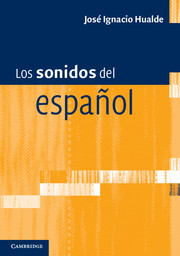Book contents
- Frontmatter
- Índice general
- Lista de figuras
- Lista de tablas
- Prefacio
- Lista de abreviaturas y convenciones
- El Alfabeto Fonético Internacional
- 1 Introducción
- 2 Consonantes y vocales
- 3 Caracterización acústica de las principales clases de sonidos del español
- 4 La sílaba
- 5 Principales procesos fonológicos
- 6 Vocales
- 7 Consonantes oclusivas
- 8 Fricativas y africadas
- 9 Nasales
- 10 Líquidas (laterales y vibrantes)
- 11 Principales alternancias morfofonológicas
- 12 El acento
- 13 Entonación
- 14 Variación en la pronunciación del español
- Apéndices
- Glosario de términos técnicos
- Bibliografía
- Índice alfabético
13 - Entonación
Published online by Cambridge University Press: 05 June 2014
- Frontmatter
- Índice general
- Lista de figuras
- Lista de tablas
- Prefacio
- Lista de abreviaturas y convenciones
- El Alfabeto Fonético Internacional
- 1 Introducción
- 2 Consonantes y vocales
- 3 Caracterización acústica de las principales clases de sonidos del español
- 4 La sílaba
- 5 Principales procesos fonológicos
- 6 Vocales
- 7 Consonantes oclusivas
- 8 Fricativas y africadas
- 9 Nasales
- 10 Líquidas (laterales y vibrantes)
- 11 Principales alternancias morfofonológicas
- 12 El acento
- 13 Entonación
- 14 Variación en la pronunciación del español
- Apéndices
- Glosario de términos técnicos
- Bibliografía
- Índice alfabético
Summary
Tono y entonación
El tono con que pronunciamos una sílaba o secuencia de sílabas viene determinado por la frecuencia de vibración de las cuerdas vocales. Una frecuencia de vibración más alta produce un tono más alto y una frecuencia de vibración más baja, un tono más bajo o grave. El correlato acústico es la frecuencia fundamental de la onda sonora, que se abrevia como F0 (“efe cero”) (véase la sección 3.2)
En todas las lenguas habladas se utiliza la variación tonal con propósitos lingüísticos. En algunas lenguas, que conocemos como lenguas tonales, el tono se emplea para establecer contrastes léxicos. Una de estas lenguas es el chino mandarín, donde, por dar un ejemplo conocido, la sílaba /ma/ puede tener cuatro significados diferentes según el tono con que se pronuncie. Con tono alto sostenido significa ‘madre’; con tono ascendente empezando desde una altura media, ‘cáñamo’; con un contorno bajo ascendente-descendente, ‘caballo’, y con tono descendente desde un punto de partida alto, ‘reñir’. (Al final de una frase y con tono neutro, /ma/ es también una partícula interrogativa.) Además del chino, el tailandés, el vietnamita y otras lenguas del sudeste asiático, son también tonales casi todas las lenguas del Africa subsahariana, así como muchas lenguas indígenas de México y Centroamérica, entre otras.
- Type
- Chapter
- Information
- Los sonidos del españolSpanish Language edition, pp. 260 - 282Publisher: Cambridge University PressPrint publication year: 2013



